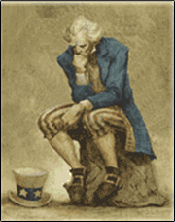
–>
April 27, 2023
To say that things have become upside down in American society in the last 20 to 30 years or so is the understatement of the year. However, to be perfectly fair, every succeeding younger generation has been met with calls of derision and criticism by the older generation. The cries of, “What they show on TV! Listen to those song lyrics! I can’t believe what kids are getting away with!” are a constant with every new generation. Nothing new there.
‘); googletag.cmd.push(function () { googletag.display(‘div-gpt-ad-1609268089992-0’); }); }
It is true that every new age seems to bring with it a relaxation of moral standards, a redrawing of previously held moral lines in the sand, a new interpretation of what is considered normal and acceptable. In the 1950s, TV married couples were shown sleeping in twin beds, separated by a three-foot-wide nightstand. That’s ridiculous by today’s standards.
Yet, there was a certain order to things in days gone by, an underpinning of absolute right and wrong that served as the foundation of the house of societal order, even as the “upper floors” of swearing on TV or nudity in movies or vulgarity in music lyrics changed and became looser and more risqué.
To wit, right through the 1980s, these aspects (among many others) of American culture remained largely unchanged from the 1950s:
- Kids did their homework, didn’t talk back to their teachers and rarely entertained the idea of cheating.
- The thought of “being called down to the principal’s office” was a serious and intimidating matter.
- As a young person, your mind was oriented towards finishing school, perhaps going on to college or trade school, getting a job, getting married and raising a family.
- The phrase, “Wait until your father gets home!” was truly frightening to a misbehaving child.
- If a girl “got into trouble,” it was a point of life-disrupting sadness at the least and a complete family humiliation at the worst.
- Underaged smoking, drinking or drug use was seriously frowned upon, explicitly punishable by law and a cause for social repudiation. Individual reputations were often broken, with life-long implications.
‘); googletag.cmd.push(function () { googletag.display(‘div-gpt-ad-1609270365559-0’); }); }
All these facets of American life through the 1980s were tied together by one common element: The majority of American households with children were two-parent households. There were, of course, a minority of one-parent households by way of divorce or early death, but those were the exception. Two-parent households were the norm.
 Before 1980, out-of-wedlock births were a small minority of the total. Since the 1990s that number has risen to over 40% of all births — which is an astonishing number! — and is even higher among the Black and Hispanic communities (estimated at 70% and 51% in 2018, respectively).
Before 1980, out-of-wedlock births were a small minority of the total. Since the 1990s that number has risen to over 40% of all births — which is an astonishing number! — and is even higher among the Black and Hispanic communities (estimated at 70% and 51% in 2018, respectively).
The decline of the two-parent household since around 1990 has ushered in a marked deterioration in the decency and ethical principles of American life. Proponents of the so-called “enlightenment” and “tolerance” of current social norms and behaviors may scoff at the attitudes and practices of the 1960s or 1980s, but the nuclear two-parent families of a few decades ago did, in fact, impart a structured, widely accepted and absolute sense of “right and wrong” that today’s youth simply don’t have. The rules of right and wrong transcended racial and demographic boundaries and were independent of income or social class. Everyone knew what was “right” and what was “wrong.” That certainly doesn’t mean everyone adhered to the rules; they didn’t. But everyone knew the rules. Kids were taught by their families that you went to school, respected your elders, behaved properly in public (good table manners and no bad language at a restaurant, no chewing gum in church/synagogue, held the door for elders/women, that kind of thing), showed up for work on time and gave it a good effort, kept your word, didn’t steal or cheat, and so on. These were the rules. We all knew them.
That knowledge of right and wrong is the glue that holds civilized society together and enables it to operate correctly.
Translated from childhood behavior to adult workplace practices, the time-honored rules of right and wrong provide the guidelines for the proper functioning of business relationships in a market economy.
In a capitalistic system, there is a high degree of intrinsic trust and expectation between the buyer/seller participants. Each party expects the other to operate within the bounds of ethical behavior. While there is complete understanding by each side that the other will endeavor to leverage the transaction to their maximum advantage (the seller tries to maximize their profit, while the buyer seeks the best deal and terms), this marketplace adversarial confrontation is underpinned by the assumption of a basic, inherent “fairness” to the game. Within the rules of right and wrong, each side is free to exercise their skill and experience to achieve the most advantageous outcome possible. However, the system only works when both sides recognize that the overall game is, indeed, governed by the notion of the rules of right and wrong — rules that have been imparted generation after generation by the structure of the two-parent nuclear family.
‘); googletag.cmd.push(function () { googletag.display(‘div-gpt-ad-1609268078422-0’); }); } if (publir_show_ads) { document.write(“
The exact same holds true for politics and the justice system. We all understand how things are supposed to be, what fairness and evenhandedness are and how the pillars of government and the courts should act. While there is widespread recognition that there has always been some degree of “law for the privileged” (ranging from fixing a speeding ticket to non-prosecution for the child of a senator), for the most part, the average citizen could count on a reasonably fair shake at the hands of the law.
Likewise in politics, people used to have fairly high confidence in the integrity of our electoral system and the notion that most public servants were there, in fact, to serve the public.
But now, everything that defined the successful, legitimate functioning of the American capitalistic democracy is coming under serious question. People have lost faith in marketplace fairness. Businesses are thought to cheat and discriminate, so people feel no compunction stealing from them. Young congresspeople accept gifts of expensive clothing and commit insider trading crimes based on their exclusive foreknowledge of pending legislation, yet they publicly criticize those who dare object. All manner of aberrant personal behavior (such as men identifying as women so they can invade the girls’ locker room) is excused under the disingenuous guise of “tolerance.”
The word democracy, for Americans, has come to represent more than just a voting system. Our democracy stands for the opportunity to choose one’s work, to build a life of one’s choosing, to be treated fairly under the law as long as one follows the rules and to essentially have the freedom to live without the fear of oppressive governmental dictates, all the while having the ability to have your voice heard in a legitimate way, by vote or petition or peaceful demonstration.
Democracy stood for all this because of the deep-rooted concepts of right and wrong, as taught to children for generations by law-abiding two-parent families. When you take away the two-parent family, American democracy, as defined above, collapses like a wobbly Jenga tower.
Image: RawPixel.com
<!– if(page_width_onload <= 479) { document.write("
“); googletag.cmd.push(function() { googletag.display(‘div-gpt-ad-1345489840937-4’); }); } –> If you experience technical problems, please write to [email protected]
FOLLOW US ON
<!–
–>
<!– _qoptions={ qacct:”p-9bKF-NgTuSFM6″ }; ![]() –> <!—-> <!– var addthis_share = { email_template: “new_template” } –>
–> <!—-> <!– var addthis_share = { email_template: “new_template” } –>





